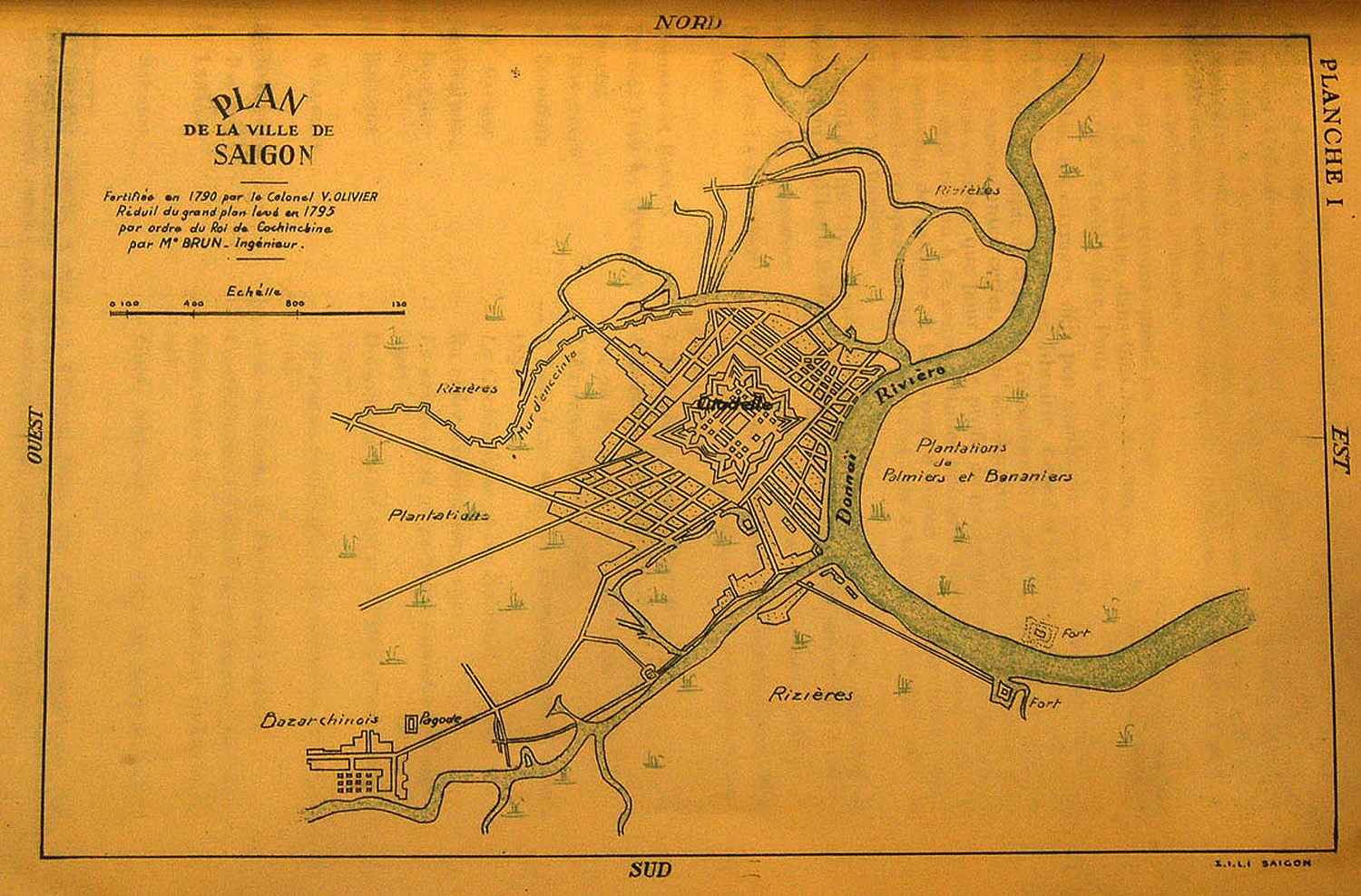
A late 18th century map of Saigon
On 7 October 1819, Lieutenant John White (1782-1840), a member of the East India Marine Society of Salem, Massachusetts, arrived in Saigon in the US Navy brig Franklin. His account of his visit, published in A Voyage to Cochinchina by John White, Lieutenant in the United States Navy (Boston, 1823), has been described by Robert Hopkins Miller (The United States and Vietnam, 1787-1941. National Defense University Press, 1990) as “a vivid example of an early American reaction to the Vietnamese and their ways.” This is the second excerpt from the book describing his experiences in the Saigon of King Gia Long’s reign.
To read part 1 of this serialisation click here
The city of Saigon contains 180,000 inhabitants; of which about 10,000 are Chinese, according to the authentic and official statements which I received from Father Joseph (of whom I shall have cause to speak hereafter) and from the military governor, or Viceroy, who returned from the city of Hue a short time after our arrival.
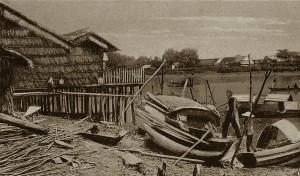
Environs de Saigon – Habitations de pêcheurs
It is situated on a point formed by the confluence of two branches of the Don-nai River, and occupies about 6 miles of the north bank. The population is dense near the river, but scattered farther remote from it. The houses are built principally of wood, thatched with palm leaves or rice straw, and are of one storey. Some few are of brick, and covered with tiles. Those of the higher classes have hanging chambers, built under the roof-tree, about 10 feet wide, extending the whole length of the building, with wooden gratings on each side for air, to which they ascend by ladders; those of the latter description are surrounded by a court, with a gate towards the street; but the dwellings of the poor are situated on the streets, and generally present a miserable appearance. In vain does the traveller look for the glazed windows, so indispensable for the comfort of an European. The clumsy wooden shutters must be thrown open for light; and when the weather is so bad as to oblige the inhabitants to close them, these wretched abodes are cheerless in the extreme. Misery and filth here hold their undisputed reign.
The streets are regularly laid out, generally intersecting each other at right angles, and some of them are quite spacious.
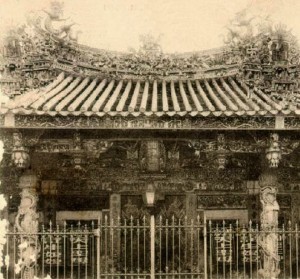
A Fujianese pagoda in Chợ Lớn
In the western part of the city are two Chinese pagodas, and the Annamites have a great number of these temples in various parts of the city. In a central situation is a Christian church, where two Italian missionaries preside, who have several disciples and many converts. The number of Christians in Cochin China is 70,000, of which number the division of Don-nai contains 16,000 (according to the Viceroy and the missionaries). They are all Roman Catholics. The Annamites have no towers to their pagodas; the bells, of which there are generally from two to four of different sizes to each place of worship, are hung on wooden frames before the entrance, and are never swung, but struck by hand. They differ in shape from those of European construction, for they bear a nearer resemblance to a truncated cone.
Equidistant from the extremities of the city, near the bank of the river, is a long range of buildings of handsome construction; these are the magazines of rice, which is a regal monopoly, and the exportation of it prohibited on pain of decapitation; each vessel departing from the country being allowed a certain quantity for provisions, in proportion to the number of her crew, and the anticipated length of the passage. A large Siamese junk was lying hauled up in a creek on the Banga [Bến Nghé] side of the river, the captain and officers of which had been executed a short time previous to our arrival, and the crew was then in prison for violation of this edict.
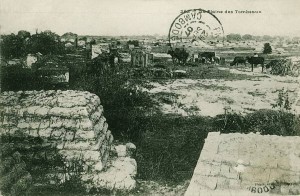
The Plain of Tombs
The ground in the northern part of this city is occupied, for a space of two miles by about three-fifths of a mile square, as a repository for the dead; and this immense cemetery is filled with tombs, built like those of the Chinese, in the form of a horseshoe. Its borders are planted, as are many of the streets in the suburbs, with the palmaria tree, resembling, if the comparison be not too daring, the boulevards at Paris.
In the north-eastern part of the city, on the banks of a deep creek, is the navy yard and naval arsenal, where, in the time of rebellion, some large war junks were built; and two frigates of European construction, under the superintendance of French officers. This establishment does more honour to the Annamites than any other object in their country; indeed, it may vie with many of the naval establishments in Europe. There were no large vessels built, or building; but there were ample materials of the most excellent kind, for several frigates. The ship-timber and planks excelled anything I had ever seen. I measured one plank whose dimensions were 109 feet long, more than 4 inches thick, and perfectly square to the top, where it was 2 feet wide. It was sawn out of the trunk of a teak tree, and I believe that there is no part of the world where these gigantic sires of the forest arrive in such magnitude as in Cochinchina. I have seen in the country a tree that would make a natural main-mast for a line of battleship, clear of knots; and this, I learned, is not unusual.
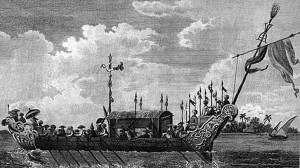
An early 19th century drawing of a small Nguyễn dynasty warship
There were about 150 galleys of most beautiful construction, hauled up under sheds; they were from 40 to 100 feet long, some of them mounting 16 guns of three pounds calibre. Others mounted four or six guns each, of from four to 12 pounds calibre, all of brass, and most beautiful pieces. There were, besides these, about 40 other galleys afloat, preparing for an excursion that the Viceroy was to make up river on his return from Hue. Most of these were decorated with gilding and carved work, “pennons and streamers gay,” and presented a very animated and pleasing spectacle.
The Annamites are certainly most skilful naval architects, and finish their work with great neatness. I was so much pleased with this portion of their political economy that I made frequent visits to the naval arsenal.
The iron used in the southern provinces is generally brought from Siam in pigs, and is highly malleable and ductile. A harder and more brittle kind is produced in the northern section of the country bordering on Tonkin, and is in more general use there. There was formerly a cannon foundry in Saigon, under the direction of the Bishop of Adran; and the ruins of another are still standing in the city of Don-nai. As at Hue, there is one in full operation, where artillery of all calibres is cast in brass; copper being produced on the confines of Tonkin, and lapis calaminaris found in abundance.
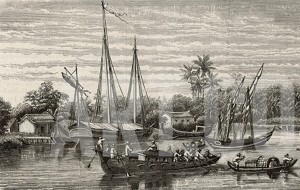
The right bank of the Saigon river
The city of Saigon was formerly confined to the western extremity of its present site, now called old Saigon, and which part bears much greater marks of antiquity, and a superior style of architecture. Some of the streets are paved with flags; and the quays of stone and brick work extend nearly a mile along the river. The citadel and naval arsenal, with the exception of a few huts for the artificers, were the only occupants of the grounds in the eastern quarter; but since the civil wars have ended, the tide of population has flowed rapidly to the eastward, till it has produced one continued city, which has spread itself to the opposite bank of the streams on which it is situated, and surrounds the citadel and naval arsenal.
From the western part of the city, a river or canal has been recently cut (indeed, it was scarcely finished by the time we arrived there), 23 English miles connecting with a branch of the Cambodia river, by which a free water-communication is opened with Cambodia, which is called by the Annamese “Con-maigne.” This canal is 12 foot deep throughout; about 80 feet wide, and was cut through immense forests and morasses, in the short space of six weeks. Twenty six thousand men were employed, night and day, by turns, in this stupendous undertaking, and 7,000 lives sacrificed by fatigue and consequent disease. The banks of this canal are already planted with the palmaria tree, which is a great favourite with the Annamites.
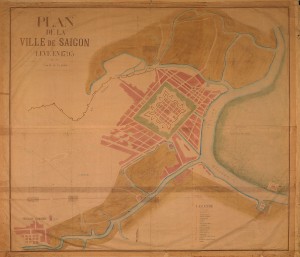
A 1795 map of Saigon
The site of the citadel of Saigon is the first elevated land which occurs in the river, after leaving Cap St Jacques, and this is but about 60 feet above the level of the river: it was formerly a natural conical mound, covered with wood. The grandfather of the present monarch caused the top to be taken off and levelled, and a deep moat to be sunk, which was supplied with water from the river by means of a canal. It is most admirably suited for defence, and would be capable, when placed in a proper posture, of standing a long siege, against even a European army. The walls were destroyed in the civil wars, but were subsequently rebuilt in better style than formerly. The surrounding country is irriguous, and the city is intersected, in various parts, by creeks, over which are thrown bridges, each being a single plank of immense magnitude.
Saigon is within a few miles of the head of the ship-navigation of that branch of the Don-nai river on which it is situated. It is there interrupted with shoals and sand banks, but is navigable for the country craft for a great distance inland, which, in fact, is the case with the stream washing the southern borders of the city, which, with the new river, connects the Cambodia and Don-nai rivers, that branch south of the city having, in many places, not more than 12 feet high of water.
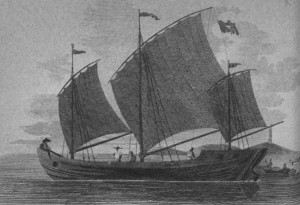
A merchant ship in the East Sea by John White
On our return on board, we found some officers who had been dispatched by the governor to acquaint us that the following day was proposed for the “ceremony of measuring the ships;” for a ceremony, we were told, it invariably had been, and could not be dispensed with, and it was expected that a feast would be prepared for the throng of officers who would visit us on this occasion.
In this emergency, we consulted Joachim and Pasqual, and learned that it never had been dispensed with on former occasions, and it would be for our interest to comply with the best grace we could. Preparations were accordingly made to receive them, under the superintendence of Pasqual’s wife, who, on the occasion, produced an abundance of dishes of various kinds, principally of oriental origin; such as pilaw, curry, mulligatawny, kedgeree, etc, and great varieties of confectionary and fruits. Our fears were not a little excited that these hot and pungent dishes would require no small quantities of diluents to assist their powers of deglutition, and they were confirmed by the linguists, who told us that it would be expected, and refusal would give offence. To eke out our own stock, we purchased some of the whiskey of the country, made of rice, to administer to them, mixed with European liquors; and this we found, on trial, took so well that on subsequent occasions we constantly practiced it, but we were obliged to be cautious not to administer it till they began to be pretty tipsy, for fear of detection. In fact, towards the catastrophe, rice-whiskey answered every purpose.
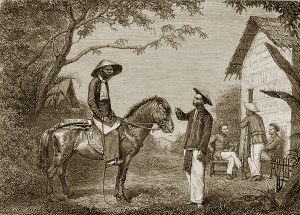
Soldiers and cavalry in Saigon, from the journal “Tour du Monde” by French naturalist Dr Morice (1872)
In the pursuance of arrangements made the day previous, at about nine o’clock on the morning of Sunday 10 October, our boats were sent to escort this gang of spongers on board; and in about half an hour, we descried a fleet of the country boats, preceded by those of the ships, and tilled with persons of various ranks, putting off from the shore near the great bazaar, and in a few minutes they were alongside the Franklin.
The commissary, whom we have before mentioned and to whom we became subsequently attached, in consequence of his being less of a rogue than the generality of these people, was the first who presented himself. He was followed by the collector of the customs, a covetous looking old hunk whose nose and chin were in close intimacy, and whose subsequent conduct did not belie our skill in physiognomy. In his suite were many others of various ranks who, with their long trains of servants, filled the decks with their bodies, and the air with the perfumes from them.
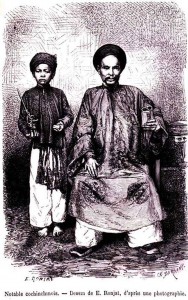
An Annamite notable, from the journal “Tour du Monde” by French naturalist Dr Morice (1872)
Immediately after the first introduction, which was conducted with some ceremony, though with little civility (the latter of which, in the common occurrences of social intercourse with strangers is but little known and less practiced in Annam), demands were made for liquors, and as we were anxious to get rid of them as speedily as possible, we hastened to gratify them, and then urged them to proceed to business. It was not, however, till after a long consultation in which they were frequently very loud and vociferous, that they commenced their operations, the manner of which was as follows:
A line, perpendicular to each end of the keel, is marked on deck; one third of the distance from the mark nearest the stern to that forward is set off for the place of admeasurement, where a straight pole, or strip of wood, is placed horizontally across the ship, over the rail or gunwale, from which plummets are suspended, in order to find a line perpendicular to the wales, or extreme diameter of the ship in that part which is marked on the pole. On this measurement, the tonnage-duty is payable by the touick or covid, a measure of sixteen and six-tenth inches, which is divided into decimal fractions which are called by the natives tăt and by the linguists puntas, from the Portuguese, thus: 10 tăt makes a touick, or covid. The exaction on this measurement is made at the rate of 160 quans, or eighty Spanish dollars per covid. On the amount so found, there is an imposition of three per cent, to pay the officers for the “trouble and expense” of measuring. Another exaction of one per cent is made in favour of the soldiers or attendants, for the “trouble and expense” of looking on; and, to crown this climax of extortion, the government allows but 18 mace, called by the Annamites tien (each equal to 5 cents) for a Spanish dollar, when paid them for anchorage, etc; whereas, in the bazaars and in all other commercial operations, the dollar is always worth 2 quans, of 10 mace each. The mace is divided into 60 parts, called dong by the natives, and sapeks by the Portuguese. Sixty dong or sapeks make 1 tien or mace = 5 cents, and 10 tien or mace make 1 quan = 50 cents.
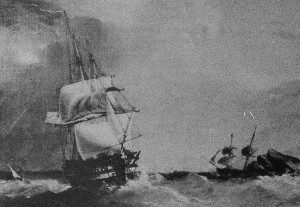
White’s vessel the USS Franklin, pictured rounding Portovenere near La Spezia in about 1819
The Franklin measured 17 covids and six puntas, or tenths, at 160 quans per covid this made 2,816 quans. The amount of three per cent for the officers’ fees amounted to 85 quan, 3 mace, 24 sepeks, and the amount of one per cent for the soldiers amounted to 28 quan 1 mace, 37 sepeks. In total, this was 2,929 quan 5 mace 1 sepek, which sum, at 18 mace to the dollar, makes nearly 1,627 Spanish dollars 45 cents per ton, the Franklin being 252 tons burden.
After having settled the measurement, which was not done without some quarrelling between the commissary and the collector, on whom their potations seemed to have contrary effects, the former strongly inclining to favour us, and the latter to cheat us by extending the measure, they proceeded to gorge themselves with what had been prepared for them.
It would afford but little, if any, amusement to recapitulate the scene of debauchery which ensued. Suffice it to say that at about 12 o’clock, they proceeded on board the Marmion, where the same shameless conduct was repeated; the quarrel about measurement, however, being carried on with rather more asperity than before, the old collector’s rapacity increasing in a ratio with his ebriety.
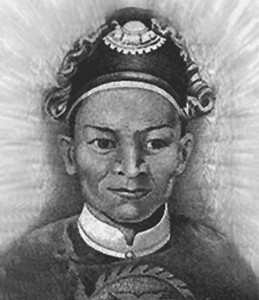
Marshal Lê Văn Duyệt, Royal Viceroy in Gia Định at the time of John White’s visit
At about 4 o’clock, much to our satisfaction, they departed pêle-mêle and left us in possession of quiet, but by no means clean ships. Among the other impurities, not the least disgusting was the saliva impregnated with their masticatory, which had been liberally ejected in every part, as chance might direct, leaving crimson spots which required no little labour to efface.
On the following day, we paid another visit to the governor, for the purpose of regulating the amount of sagouètes, etc. On this occasion, after being detained a few minutes in the guard house in front, we were introduced to the interior of the house where we found him in a large apartment, which contained a small library, a couch, and near this a small raised platform on which he was seated on some furniture of Chinese manufacture. He had on this occasion no retinue, but two boys in attendance, one of whom was fanning him. He received us graciously, requesting us to sit down, when we were presented, as usual, with tea, areca and sweetmeats.
After gratifying his curiosity with regard to several questions he asked about Europe, associating America with it (calling them indiscriminately Olan), we introduced the subject of sagouètes. He informed us that there was a fixed and immutable law of the kingdom, regulating these matters, which he dared not pretend to abrogate or evade; and even if he wished to do it, there were so many other officers who were to participate with him that the attempt must necessarily prove entirely futile. After an interview of about three quarters of an hour, we arose to depart, when he said something to the linguists, who desired us to be reseated. They told us that the governor was about dispatching a courier to the king, with the official papers relative to our arrival, etc, and desired to know if we wished to send him any present. We answered in the affirmative, and knowing there was a French naval officer in the service of this monarch, we requested permission to write to him, which he readily granted. We then took our leave, after promising to have our present and letter ready early on the ensuing morning.
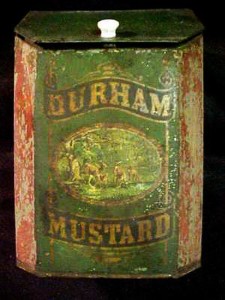
King Gia Long was very partial to Mrs Clements’ Best Durham Mustard
On our return on board, we were met by the commissary in company with another officer; the latter invited us into his house, which was near. After tea, betel etc, our host brought us an empty mustard bottle, with the arms of the King of England upon a label attached to it, and “Best Durham Mustard” in large letters underneath, and upon a piece of paper, which was produced, something had been spread. It resembled an apothecary’s plaster, but dried, black, and without smell or taste. This, they observed, was a sample of what the bottle had formerly contained, and inquired if we had any of that article on board. We answered in the affirmative and that we had brought some expressly for the king. At this they were highly gratified, and told us that his majesty was extravagantly fond of that article and had sent the bottle and paper carefully packed from Hue some months previous, as a specimen to exhibit to strangers, of what he wanted to procure. The same exhibition had been made to us at Turon [Tourane, Đà Nẵng] in the preceding June, which induced us to procure a good supply of that article at the Philippines, previous to returning from thence to Cochin China.
We prepared, upon our return on board, a letter in French to Monsieur Vannier, the king’s admiral in Hue, requesting his good offices on our behalf, and that he would endeavour to procure a reduction of the sagouètes; and he was requested to present to his majesty an elegant sabre, which accompanied the letter. On the following morning, the linguists and several officers appeared and demanded the present for the king, which was delivered to them. They were very much delighted with the beautiful polish and decorations of the blade and its splendid mountings, and the interjection, Kaa! Kaa! expressive of wonder, or surprise, was repeated with great emphasis. The letter was then given to them for Monsieur Vannier, to which a dozen bottles of mustard for the king was added when they departed; not, however, till they had each begged and received a copious dram.
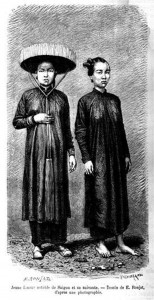
Annamite women, from the journal “Tour du Monde” by French naturalist Dr Morice (1872)
Scarcely had the party taken leave, before we were visited by a bevy of women, whom we found were merchants, or rather merchandise-brokers: they, after asking and receiving a glass of brandy each, began to open their business, offering sugar, silk, cotton, and other articles for sale, but produced no samples. We were astonished to find that the price of sugar, which they knew was the primary article with us, or at least, what had most inquired for, had risen from 80 to 100 per cent since our arrival, but that other articles had not advanced in the same ratio, by any means. Finding this to be the case, we were more particular in our inquiries for silk, cotton, gamboodge and other articles, the reputed productions of the country, of which we ordered them to bring samples after being told their respective prices. After a long interview, during which we were fully satisfied of the shuffling, chicanery and rapacity of the merchants, they departed, promising to see us the next day.
They were punctual to their appointment, but did not bring any specimens of their goods. Our astonishment may, however, be conceived, when they informed us that the commodities of which we had inquired yesterday had advanced about 50 per cent in price. It would be tedious to the reader, and painful to myself, to recapitulate the constant villainy and turpitude which we experienced from these people during our residence in the country.
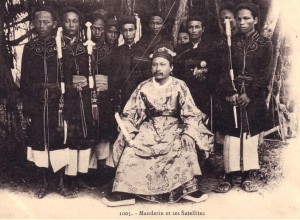
A Nguyễn dynasty mandarin
Their total want of faith, constant eagerness to deceive and over-reach us, and their pertinacity in trying to gain by shuffling and manœuvring, what might have been better and easier gained by openness and fair dealing; the tedious forms and ceremonies in transacting all kinds of business, carried into the most trifling transactions; the uncertainty of the eventual ratification of any bargain (the least hope of wearing the patience of the purchaser out, and inducing him to offer a little more, being sufficient to annul any verbal stipulation) and there being no appeal, unless there is a written contract, which is never made, till every art has been used, and every engine of extortion put in motion and exhausted to gain more; all of these vexations, combined with the rapacious, faithless, despotic and anti-commercial character of the government, will, as long as these causes exist, render Cochin China the least desirable country for mercantile adventurers.
These causes have made the Japanese relinquish the trade: they have driven the Portuguese of Macau from the country, and turned their commerce into other channels; and are yearly and rapidly lessening their intercourse with China and Siam. The philanthropist, the man of enterprise, and the civilised world generally, can see in the present miserable state of this naturally fine country no other than a source of deep regret and commiseration.
Tim Doling is the author of the guidebook Exploring Saigon-Chợ Lớn – Vanishing heritage of Hồ Chí Minh City (Nhà Xuất Bản Thế Giới, Hà Nội, 2019)
A full index of all Tim’s blog articles since November 2013 is now available here.
Join the Facebook group pages Saigon-Chợ Lớn Then & Now to see historic photographs juxtaposed with new ones taken in the same locations, and Đài Quan sát Di sản Sài Gòn – Saigon Heritage Observatory for up-to-date information on conservation issues in Saigon and Chợ Lớn.

